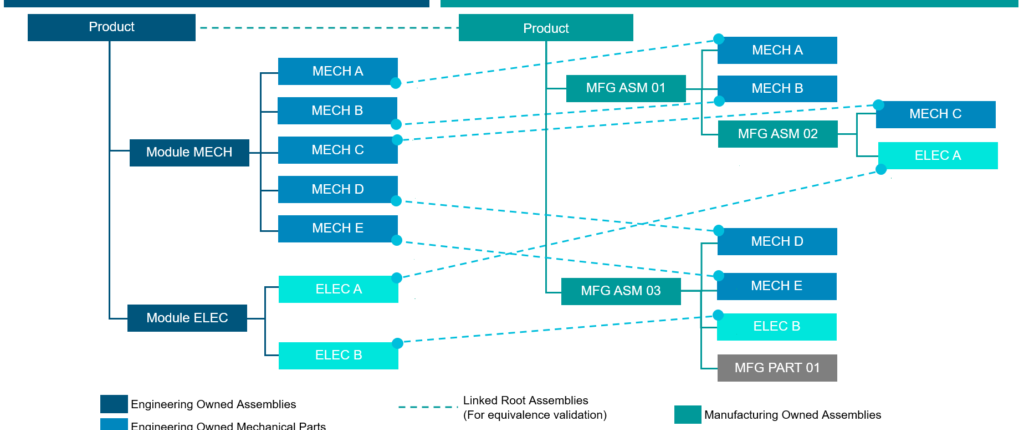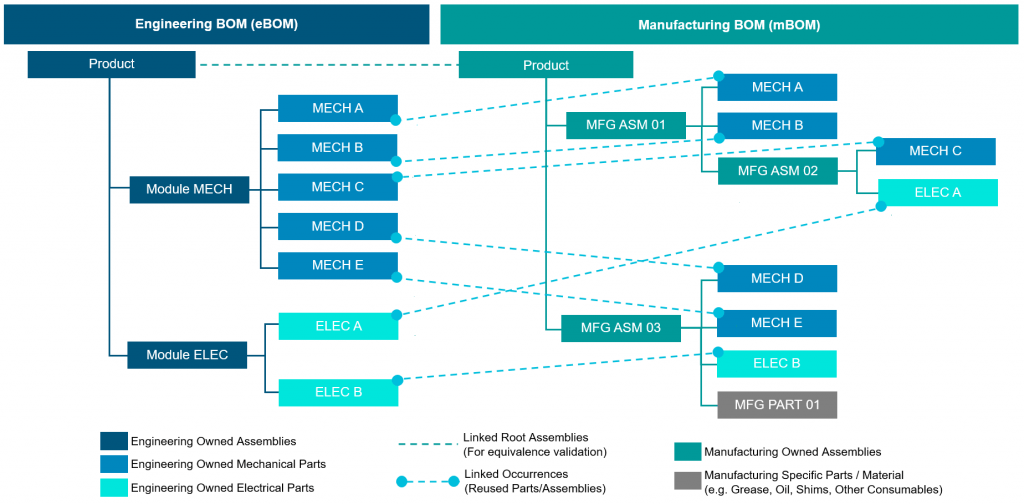
Manufacturing Bill of Materials (mBOM). Improve your manufacturing efficiency and address new challenges by avoiding delays, compliance risks, and quality misses with an integrated manufacturing bill of materials as part of your digital manufacturing strategy.
Traceability and accuracy of your mBOM is key to a successful digital manufacturing strategy.

Challenges to productivity in manufacturing
For many manufacturers, one of the most common disruptive issues to the productivity of manufacturing operations is the lack of necessary material to produce products. While many times these inventory shortages are due to influences outside your control such as supplier delays or global disruptions in the supply chain, other shortages and issues are completely within your control. For example, data gaps or errors that are created by disconnects between engineering and the supply chain. Forgetting to populate a make/buy value, or using an incorrect unit of measure may seem inconsequential, but this can drive incorrect inventory levels or required parts to not be ordered at all. Many times, these unintended inventory gaps will not get discovered until there is demand on incoming orders, creating the potential for serious disruptions. Also, beyond just understanding the material requirements there is also the need to evaluate the BOM for manufacturability and understand the potential impact to your processes and equipment. These issues are only going to increase with the growing complexity of your products, and as the demand for new features drive ongoing change.
You may have implemented some level of manufacturing bill of materials (mBOM) management that provides the orderable BOM within your ERP system. However, this mBOM, if manually replicated and based on the related engineering BOM, provides plenty of potential for human error. Even when automated transfers of data are implemented, they typically lack the necessary processes and accountability to ensure accuracy of the data. Another common pitfall is relying on your engineering department to manage your mBOM definition based on the manufacturing and supply chain requirements. This can incur unnecessary design changes and cost that provides no added value to your products. In fact, this could likely creating new issues and delays due to the volume of change, increasing the chances for error. For example, in multi-plant scenarios, there can be significant non-value add changes created by engineering just to manage plant specific manufacturing assemblies required to support the material breakdown and flow of work orders.
Another approach is to allow manufacturing to manage a unique view of the mBOM directly within the ERP system. This approach creates a complete disconnect and lack of traceability to the engineering intent, introducing the possibility of significant quality or compliance escapes. Another disconnect that stems from not leveraging integrated manufacturing tools is lack of collaboration between engineering and manufacturing domains. With limited collaboration, you reduce your potential for early manufacturing validation that helps to identify critical issues sooner. This disconnect can also drastically increase the time required to implement new products or changes due to the sequential “throw it over the wall” nature of this approach.
Integrated manufacturing bill of materials
Implementing an integrated, collaborative manufacturing BOM within your PLM system, that is directly linked to the engineering definition, you get a mechanism for manufacturing and engineering to collaborate much earlier in the product lifecycle. This linkage also provides enhanced re-use of existing information, beyond just part metadata. Early-on, you can provide manufacturing controlled access to design details such as 3D models and drawings, as well as access to associated requirements and specifications. This access can allow manufacturing to assess manufacturability and provide feedback to influence the designs while the cost of change is low. Additionally, this linkage can provide your design engineers a clearer understanding of the impact of potential changes and the ability to coordinate with relevant manufacturing stakeholders based on the related mBOMs. Beyond just enabling earlier collaboration, managing the mBOM within your PLM system allows for formal change processes to be implemented. This will trigger adequate validations or signoffs to ensure the quality and accuracy of the data prior to releasing it for use downstream. A broader Manufacturing Change Notice (MCN) process could also be introduced to ensure all necessary supply chain stakeholders will be notified to acknowledge any potential impacts.

Solution for manufacturing efficiency
As you look to improve your manufacturing efficiency and address new challenges, it is critical to ensure that you have a common understanding of your products’ part requirements across your organization. Without this basic foundational data and an ability to ensure the traceability and accuracy of your mBOM data, you have the potential for delays, compliance risks, and quality misses. By introducing a solution that enables an integrated manufacturing BOM as part of a broader digital manufacturing strategy, you can provide significant benefits to your organization including:
- Avoiding costly changes with early identification of issues across the supply chain through improved collaboration between manufacturing and engineering
- Improving accountability through clear visibility of BOM impacts ensuring inclusion and sign-off from required stakeholders
- Improving customer satisfaction with improved quality and compliance through direct linkage and validation to engineering intent
- Reducing inventory costs through clear visibility to latest part requirements minimizing inventory holds and reducing scrap of obsolete parts. Avoid rework with accurate and consistent transfers of mBOM data to downstream systems (e.g. ERP, MES) ensuring the quality of BOM data across your supply chain
Teamcenter Manufacturing with Easy Plan
Teamcenter Manufacturing with Easy Plan provides you with a powerful solution to digitalize your manufacturing bill of materials. With Easy Plan, you can standardize and re-use assembly processes across multiple plants, capture work instructions for the shop floor, perform detailed time analysis, balance production lines, and much more.

> Try Teamcenter Manufacturing with Easy Plan software for free
—–

Don’t hesitate to contact Thanh for advice on automation solutions for CAD / CAM / CAE / PLM / ERP / IT systems exclusively for SMEs.
Luu Phan Thanh (Tyler) Solutions Consultant at PLM Ecosystem Mobile +84 976 099 099
Web www.plmes.io Email tyler.luu@plmes.io
